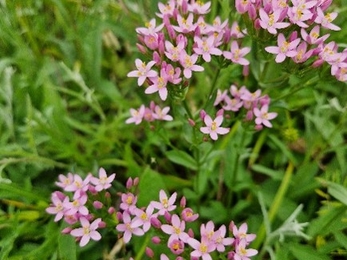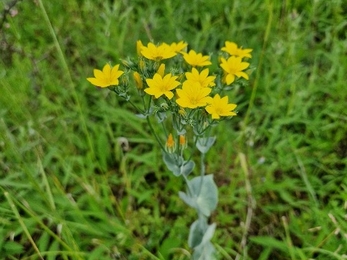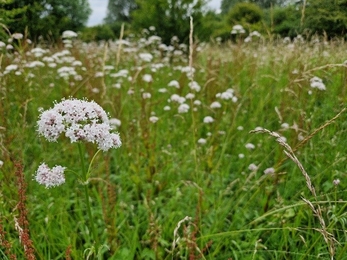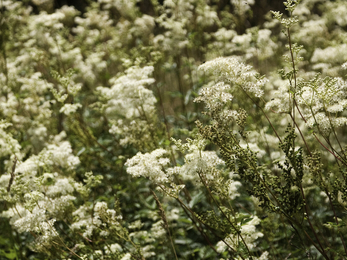The days are getting warmer at Strawberry Hill and the rows of scrub-lined paths often draw the eyes up. Willing you to peer into the scrub in search of the source of the ever-changing bird song. But look down and you might be surprised by what you find. At this time of year, the scrubby path edges put on vibrant floral displays of yellows, pinks, whites and purples. This succession of colour (weather willing) attracts throngs of equally vibrant insects, including the striking black and white marbled white butterfly, emperor dragonflies with their intensely blue and green bodies, or the sparkling iridescence of the swollen thighed beetle (yes it really is called that!).
Focus on Flora at Strawberry Hill
Image credit: Chantelle Warriner
Always a fan favourite, several orchid species have been found at Strawberry Hill. So far, we have identified common spotted orchid, with their variable upright flower stalks ranging from white to pink and dotted with purple flecks.
This species in particular has proven to be widespread across the site, often hidden in vast quantities within the scrubby grassland. Pyramidal orchids, with their bright pink flowers which form a dense pyramid shaped cluster atop a slender stem, may also be spotted along the paths at Strawberry Hill. Recently, a population of 30 or more has popped up following some targeted clearance work along our network of paths.
And finally, my favourite, a small number of the elusive bee orchid with its velvety lip which mimics the female bee, were spotted by my volunteers.
Many members of the pea family also flourish at Strawberry Hill, including the clambering meadow vetchling with its masses of yellow flowers, which climb their way up through the grasses. From June you’ll also be sure to spot its climbing relative, tufted vetch, which puts on vibrant displays of blue and purple flowers, often seen at eye height as you wander along the paths. Lower down in the sward, look out for the more delicate birds-foot trefoil, also known as eggs and bacon due to its bright yellow flowers, accented by a touch of red.
While these plants are all relatively common and widespread, a scarcer specimen recently came to our attention during a routine amble around the site. Slender tare, a delicate, trailing member of the pea family, produces enchantingly delicate flowers with hues of pink, purple and blue. This beautiful plant is restricted to lowland areas of southern England, with Strawberry Hill located in its northernmost reaches. Unfortunately, in recent years the plant has experienced substantial declines, with it now considered vulnerable in Great Britain. It is wonderful that such a vulnerable species is doing so well at Strawberry Hill, with plants now found across the site in the grassy shrubland glades.
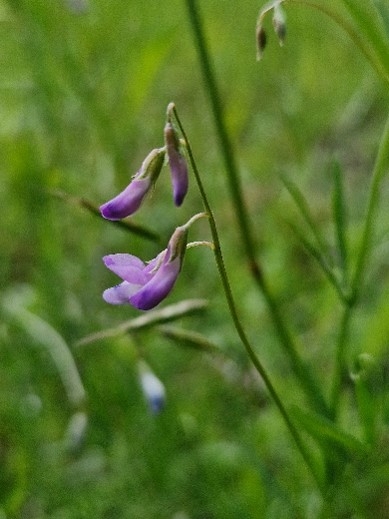
Slender tare - Chantelle Warriner
The geology, or underlying soil and rock type, of an area can have profound impacts on the flora that will thrive there. The geology of Strawberry Hill was somewhat tricky to discern when we first started surveying the site in 2022. We immediately assumed that the geology of the site must be Oxford Clay, in keeping with the surrounding landscape. But we quickly came to realise that the habitats and plants on site pointed to a different soil type. In springtime the stream, which meanders through our most extensive grassland, runs clear and is characterised by a gravelly bottom – our first clue that perhaps the site has some chalky influence.
Then, as the plants began to bloom, we noticed a scattering of species more typical of dry soils, such as common centaury with its striking pink flowers, and those typical of limestone soils, such as yellow wort, with its distinctive wraparound leaves.
A little more digging (not literally), and a walk with our friends at Natural England and we discovered that Strawberry Hill actually sits on the very edge of the Yeardley-Whittlewood Ridge, a Natural England National Character Area, defined by a ridge of limestone within a sea of clay.
Satisfyingly, the habitat description for the recently discovered Slender Tare sums up this mix of soil types perfectly - an annual plant of calcareous clay soils waterlogged in the winter months but baked dry in the summer. This theme of waterlogged soils is also reflected in the flora we see on site, particularly along the valley bottom where the stream flows through open grassland punctuated by a scattering of scrub.
Here plants such as meadowsweet, with its upright fluffy white flowers form dense, fragrant clumps. While, wild angelica, a plant of damp meadows, protrudes through the tall grasses with its tall and robust umbrella-like flower stalks, terminating in delicate pink-white flowers. A vast scattering of common valerian, an upright plant with delicate pale pink flowers, which also prefers wet soils, can be found in a discrete patch in the grassland that surrounds the farmhouse.
Thus, if we focus on flora, we find that Strawberry Hill hosts a variety of plants. From wet loving species to species more typical of dry soils and plants that thrive on chalky or limey soils. Strawberry Hill truly is a place of many and varied habitats - no doubt with many more discoveries waiting to be made.
So, when you next find yourself walking through a green space, why don’t you take a moment to focus on flora and see what it might tell you about the habitats and landscapes that surround you.







